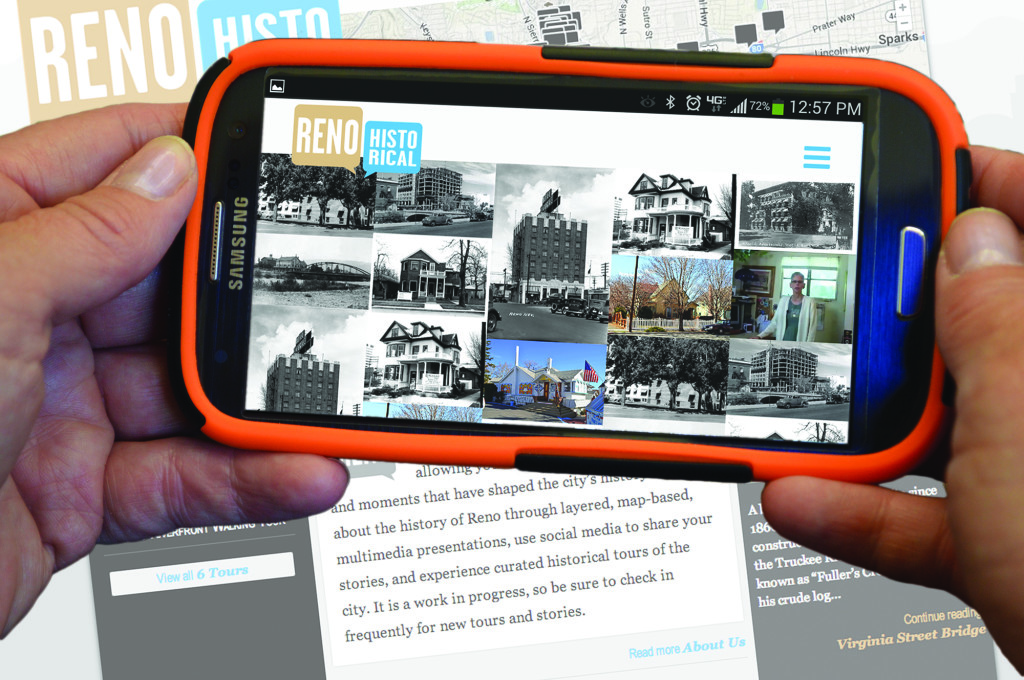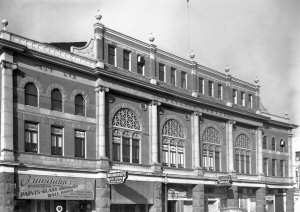Reno Historical
July – August 2014
Smartphone App Chronicles Stories of Continuity and Transformation in the Biggest Little City.
BY JERI CHADWELL | July/August 2014
Reno has been a lot of things over the years. It’s been a stop on the transcontinental railroad and a divorce capital. It’s been a gambling mecca.
But the gambling scene has been on the decline for several years now, leaving the city in a state of flux and its government and citizens searching for new ways of “reinventing Reno.” What will Reno become? Will it be a hub for technology startups, the new Silicon Valley? Will it become a staging area for outdoor enthusiasts who come to the region seeking adventure in Nevada’s expansive wilderness?
While most people continue to speculate on the development of new industries and identities—attempting to divine Reno’s future through comparisons to other great Western cities—historian Dr. Alicia Barber and University of Nevada, Reno Special Collections Director Donnelyn Curtis have been investing their time in the city’s past.
Both celebrated academics, Barber and Curtis have long dreamt of finding a way to convey engaging, accurate information about Reno’s history to an online audience. After more than a year and half of working with development partners, donors, and volunteers, they unveiled their answer: The Reno Historical mobile app and website. The app—which was released in conjunction with Reno’s “Biggest Little Birthday Party” on May 9—features map-based, multimedia stories and tours centering on some of Reno’s most prominent historical locales.
“We’re going through a big revitalization and economic diversification, and there’s so much interest in trying to discover and promote what makes Reno special and distinct, and so its history is just a natural subject to emphasize,” Barber says.
The app runs on a design framework called Curatescape. Currently employed by some 40 cities around the country, Curatescape allows content creators to curate location-based materials in a multitude of formats, including text, audio, video, and photographs. When Barber and Curtis were introduced to the framework, they knew it was ideal for the project they had in mind.
“It’s map-based, but it’s also story-based,” Curtis explains.
The result is an interactive map of Reno that users can navigate by selecting from various pinpoints, each linked to a multimedia story about a historical location. Barber and Curtis agree that it was these multimedia storytelling capabilities that made Curatescape the perfect platform for the Reno Historical project, allowing them to flesh out accurate histories, even for locations whose physical aspects have changed significantly through the course of time.
“The amazing thing is that some of the historical buildings—at first glance—aren’t,” Curtis says. “They’ve got façades, and it’s like behind this entrance, there’s the old building, and it’s really cool to see a photograph of the old building next to what it looks like now.”
“I think a big incentive to do it was to try to combat the perception that Reno doesn’t have a lot of visible history remaining because a lot of people think that it’s not that historic because it doesn’t look like Philadelphia or Boston,” Barber adds.
The app currently boasts 89 stories and six thematic tours—the result of countless hours of work by Barber, Curtis, and the project’s many volunteers. The tours, Barber explains, group together sites related to a specific subject. The “Tying and Untying the Knot” tour, for instance, gives users the chance to explore 19 locations with significant ties to Reno’s history as the divorce capital of the world.
“We started from the beginning choosing some of the greatest hits of Reno,” Barber says. “Basically, places that were universally considered historically significant, especially places that were associated with the founding sites and some of the earliest history.”
According to Curtis, there are—in addition to the 82 stories available on the app currently—60 stories under construction at present and another 100 proposed for various sites around the city. Curtis expects there will be at least 250 stories available through the app in the next few years. Each new story and tour, she says, builds upon the previous ones.
“What I love about history, is that one story leads to another story, and sometimes you find these connections that you don’t expect,” Curtis says.
In the two months since its release, the Reno Historical app has been a great a success, and Barber and Curtis look forward to moving the project forward and building the app’s reputation as a credible source of information.
“It’s been really gratifying to see the response,” Barber says. “In the first week, there were over 900 downloads of the app.”
All of the stories and tours for the project can be viewed at renohistorical.org. The mobile app is free and available through iTunes and Google Play.




